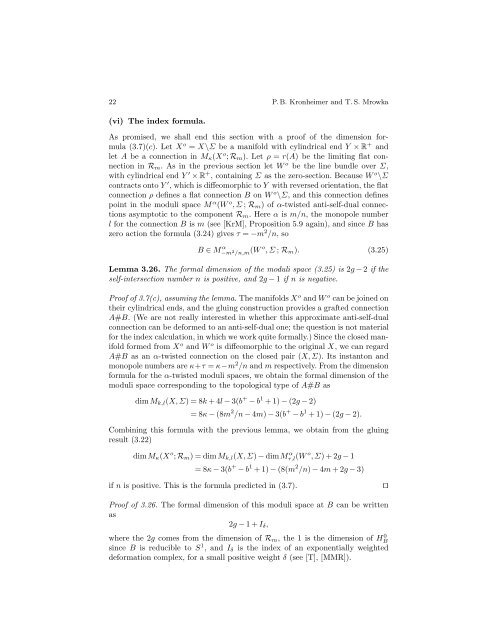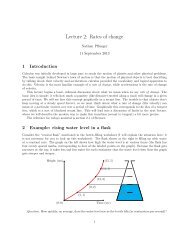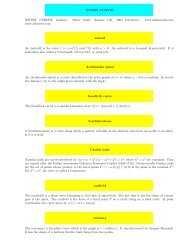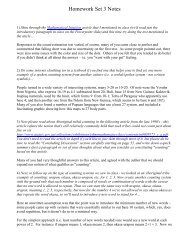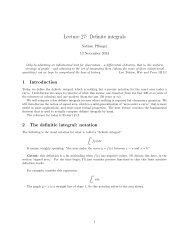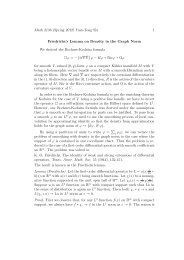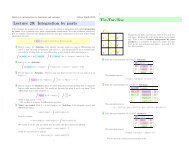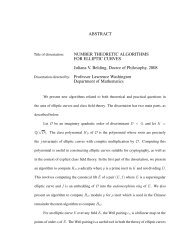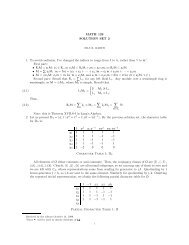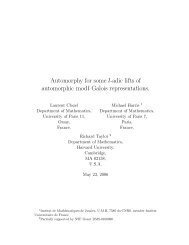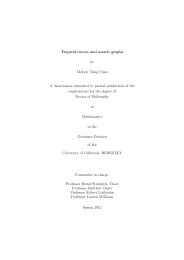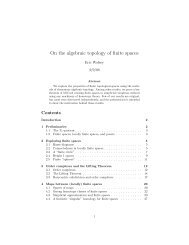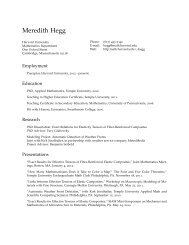Gauge theory for embedded surfaces, II
Gauge theory for embedded surfaces, II
Gauge theory for embedded surfaces, II
You also want an ePaper? Increase the reach of your titles
YUMPU automatically turns print PDFs into web optimized ePapers that Google loves.
22 P. B. Kronheimer and T. S. Mrowka<br />
(vi) The index <strong>for</strong>mula.<br />
As promised, we shall end this section with a proof of the dimension <strong>for</strong>mula<br />
(3.7)(c). Let X o = X\Σ be a manifold with cylindrical end Y × R + and<br />
let A be a connection in Mκ(X o ; Rm). Let ρ = r(A) be the limiting flat connection<br />
in Rm. As in the previous section let W o be the line bundle over Σ,<br />
with cylindrical end Y ′ × R + , containing Σ as the zero-section. Because W o \Σ<br />
contracts onto Y ′ , which is diffeomorphic to Y with reversed orientation, the flat<br />
connection ρ defines a flat connection B on W o \Σ, and this connection defines<br />
point in the moduli space M α (W o ,Σ; Rm)ofα-twisted anti-self-dual connections<br />
asymptotic to the component Rm. Hereαis m/n, the monopole number<br />
l <strong>for</strong> the connection B is m (see [KrM], Proposition 5.9 again), and since B has<br />
zero action the <strong>for</strong>mula (3.24) gives τ = −m 2 /n, so<br />
B∈M α −m 2 /n,m (W o ,Σ; Rm). (3.25)<br />
Lemma 3.26. The <strong>for</strong>mal dimension of the moduli space (3.25) is 2g − 2 if the<br />
self-intersection number n is positive, and 2g − 1 if n is negative.<br />
Proof of 3.7(c), assuming the lemma. The manifolds X o and W o can be joined on<br />
their cylindrical ends, and the gluing construction provides a grafted connection<br />
A#B. (We are not really interested in whether this approximate anti-self-dual<br />
connection can be de<strong>for</strong>med to an anti-self-dual one; the question is not material<br />
<strong>for</strong> the index calculation, in which we work quite <strong>for</strong>mally.) Since the closed manifold<br />
<strong>for</strong>med from X o and W o is diffeomorphic to the original X, we can regard<br />
A#B as an α-twisted connection on the closed pair (X,Σ). Its instanton and<br />
monopole numbers are κ+τ = κ−m 2 /n and m respectively. From the dimension<br />
<strong>for</strong>mula <strong>for</strong> the α-twisted moduli spaces, we obtain the <strong>for</strong>mal dimension of the<br />
moduli space corresponding to the topological type of A#B as<br />
dim Mk,l(X,Σ)=8k+4l−3(b + − b 1 +1)−(2g − 2)<br />
=8κ−(8m 2 /n − 4m) − 3(b + − b 1 +1)−(2g − 2).<br />
Combining this <strong>for</strong>mula with the previous lemma, we obtain from the gluing<br />
result (3.22)<br />
dim Mκ(X o ; Rm) = dim Mk,l(X,Σ) − dimM α τ,l(W o ,Σ)+2g−1<br />
=8κ−3(b + − b 1 +1)−(8(m 2 /n) − 4m +2g−3)<br />
if n is positive. This is the <strong>for</strong>mula predicted in (3.7). ⊓⊔<br />
Proofof3.26.The <strong>for</strong>mal dimension of this moduli space at B can be written<br />
as<br />
2g − 1+Iδ,<br />
where the 2g comes from the dimension of Rm, the 1 is the dimension of H 0 B<br />
since B is reducible to S 1 ,andIδ is the index of an exponentially weighted<br />
de<strong>for</strong>mation complex, <strong>for</strong> a small positive weight δ (see [T], [MMR]).


